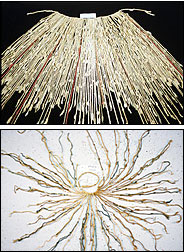http://agutie.homestead.com/files/Quipu_B.htm
Caral: Ancient Peru city reveals 5,000-year-old ‘writing’
July 19, 2005, 22:45, SABC News
Archeologists in Peru have found a “quipu” on the site of the oldest city in the Americas, indicating the device, a sophisticated arrangement of knots and strings used to convey detailed information, was in use thousands of years earlier than previously believed. Previously the oldest known quipus, often associated with the Incas whose vast South American empire was conquered by the Spanish in the 16th century, dated from about 650 AD.
But Ruth Shady, an archeologist leading investigations into the Peruvian coastal city of Caral, said quipus were among a treasure trove of articles discovered at the site, which are about 5,000 years old. “This is the oldest quipu and it shows us that this society ... also had a system of “writing” (which) would continue down the ages until the Inca empire and would last some 4,500 years,” Shady said. She was speaking before the opening in Lima today of an exhibition of the artifacts which shed light on Caral, which she called one of the world’s oldest civilizations.
The quipu with its well-preserved, brown cotton strings wound around thin sticks, was found with a series of offerings including mysterious fiber balls of different sizes wrapped in “nets” and pristine reed baskets. “We are sure it corresponds to the period of Caral because it was found in a public building,” Shady said. “It was an offering placed on a stairway when they decided to bury this and put down a floor to build another structure on top.”
Pyramid-shaped public buildings were being built at Caral, a planned coastal city 180km north of Lima, at the same time that the Saqqara pyramid, the oldest in Egypt, was going up. They were already being revamped when Egypt’s Great Pyramid of Keops (or Khufu) was under construction, Shady said. “Man only began living in an organized way 5,000 years ago in five points of the globe - Mesopotamia (roughly comprising modern Iraq and part of Syria), Egypt, India, China and Peru,” Shady said, adding Caral was 3,200 years older than cities of another ancient American civilization, the Maya.
http://www.cristobalcolondeibiza.com/2eng/2eng15.htm
THE QUIPU KNOTTED STRINGS
In Fusang: Chinos en América antes de Colón, pages 52-55, Gustavo Vargas Martínez brings up an intriguing subject that would seem to point to yet another cultural link of enormous significance in the life of pre-Columbian South America. He says that ‘special mention should be made of the knotted strings, since not only are they an element of analogical confrontation, but basically, they also represent an acquired system that has to be learnt. In his book, Histoire de la Chine the eminent Jesuit Chinese scholar, P. Martin (*) had already remarked on the ancient Chinese system of knotting strings, many years before the appearance of writing. They used to place the knots at specific intervals, make use of different colours and, by carefully following agreed rules, they created a sign code substituting other ways of counting and writing’. What is most astounding, says Vargas, is that ‘an identical system was discovered among the Incas, so sophisticated that it was used as an official register for their annals, State accounts, astronomical observations, rates and taxes and even as a means of communication, since it was used to carry news and message over long distances’. Among the Incas these strings were called quipus, and the Chinese called them qi pui, ‘back memorising’; in China today the same system is known as chie sheng. It is perfectly obvious for anyone to see that the quipu is a forerunner of the abacus (**), in common use all over Asia up to the present day.
http://bbs.cri.cn/simple/index.php?t62259.html
Bamboo Bridges
Some of the earliest of all suspension bridges were ones constructed with cables woven from bamboo strips. Throughout their long history, the Chinese have built suspension bridges to span fast-flowing rivers and deep ravines, and the Incas also designed hanging bamboo bridges as marvelous as those of the Chinese, Janssen notes.
In “China Bridge,” a team of experts brought together by NOVA constructed a suspension bridge using bamboo cables to hang the draping structure. Cabled bamboo strips once held up the great Anlan bridge on the Min River, which historians consider one of the engineering marvels of the ancient world. The bridge hung from bamboo cables from roughly the third century until 1975, when steel cables replaced the bamboo.
